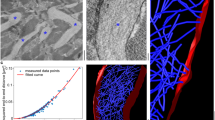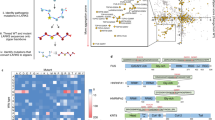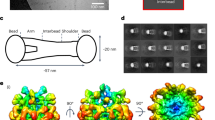Abstract
Mutations in domain 2 (D2, residues 151–266) of the actin-binding protein gelsolin cause familial amyloidosis–Finnish type (FAF). These mutations, D187N or D187Y, lead to abnormal proteolysis of plasma gelsolin at residues 172–173 and a second hydrolysis at residue 243, resulting in an amyloidogenic fragment. Here we present the structure of human gelsolin D2 at 1.65 Å and find that Asp 187 is part of a Cd2+ metal-binding site. Two Ca2+ ions are required for a conformational transition of gelsolin to its active form. Differential scanning calorimetry (DSC) and molecular dynamics (MD) simulations suggest that the Cd2+-binding site in D2 is one of these two Ca2+-binding sites and is essential to the stability of D2. Mutation of Asp 187 to Asn disrupts Ca2+ binding in D2, leading to instabilities upon Ca2+ activation. These instabilities make the domain a target for aberrant proteolysis, thereby enacting the first step in the cascade leading to FAF.
This is a preview of subscription content, access via your institution
Access options
Subscribe to this journal
Receive 12 print issues and online access
$189.00 per year
only $15.75 per issue
Buy this article
- Purchase on Springer Link
- Instant access to full article PDF
Prices may be subject to local taxes which are calculated during checkout



Similar content being viewed by others

Accession codes
References
Puius, Y.A., Mahoney, N.M. & Almo, S.C. Curr. Opin. Cell Biol. 10, 23–34 (1998).
Weeds, A.G., Gooch, J., Pope, B. & Herris, H.E. Eur. J. Biochem. 161, 69–76 (1986).
Burtnick, L.D. et al. Cell 90, 661–670 (1997).
Robinson, R.C. et al. Science 286, 1939–1942 (1999).
Pope, B.J., Maciver, S. & Weeds, A.G. Biochemistry 34, 1583–1588 (1995).
Pope, B.J., Gooch, J.T. & Weeds, A.G. Biochemistry 36, 15848–15855 (1997).
Zapun, A., Grammatyka, S., Déral, G. & Vernet, T. Biochem. J. 350, 873–881 (2000).
Kiuru, S. Int. J. Exp. Clin. Invest. 5, 55–66 (1998).
Maury, C.P., Nurmiaho-Lassila, E.L. & Rossi, H. Lab. Invest. 70, 558–564 (1994).
Maury, C.P., Sletten, K., Totty, N., Kangas, H. & Liljestrom, M. Lab. Invest. 77, 299–304 (1997).
Isaacson, R.L., Weeds, A.G. & Fersht, A.R. Proc. Natl. Acad. Sci. USA 96, 11247–11252 (1999).
Ratnaswamy, G., Huff, M.E., Su, A.I., Rion, S. & Kelly, J.W. Proc. Natl. Acad. Sci. USA 98, 2334–2339 (2001).
Kazmirski, S.L., Howard, M.J., Isaacson, R.L. & Fersht, A.R. Proc. Natl. Acad. Sci. USA 97, 10706–10711 (2000).
Puius, Y.A., Fedorov, E.V., Eichinger, L., Schleicher, M. & Almo, S.C. Biochemistry 39, 5322–5331 (2000).
Swain, A.L., Krestinger, R.H. & Amma, E.L. J. Biol. Chem. 264, 16620–16628 (1989).
Sun, H.-Q., Yamamoto, M., Mejillano, M. & Yin, H.L. J. Biol. Chem. 274, 33179–33182 (1999).
Sun, H.-Q., Wooten, D.C., Janmey, P.A. & Yin, H.L. J. Biol. Chem. 269, 9473–9479 (1994).
Robinson, R.C, Choe, S. & Burtnick, L.D. Proc. Natl. Acad. Sci. USA 98, 2117–2118 (2001).
McPherson, A. The preparation and analysis of protein crystals (John Wiley & Sons, New York; 1982).
Collaborative Computational Project, Number 4. Acta Crystallogr. D 50, 760–763 (1994).
Navaza, J. Acta Crystallogr. A 50, 157–163 (1994).
Brünger, A.T. XPLOR. A system for X-ray crystallography and NMR (Yale University Press, New Haven; 1992).
Murshudov, G.N., Vagin, A.A. & Dodson, E.J. Acta Crystallogr. D 53, 240–255 (1997).
Jones, T.A., Zou, J.Y., Cowan, S.W. & Kjeldgaard, M. Acta Crystallogr. A 47, 110–119 (1991).
Laskowski, R.A., MacArthur, M.W., Moss, D.S. & Thornton, J.M. J. Appl. Crystallogr. 26, 283–290 (1993).
Levitt, M. ENCAD — Energy calculations and dynamics (Molecular Applications Group; Stanford and Rehovot; 1990).
Levitt, M., Hirshberg, M., Sharon, R. & Daggett, V. Comp. Phys. Comm. 91, 215–231 (1995).
Case, D.A. et al. AMBER 5 (University of California at San Francisco, San Francisco; 1997).
Levitt, M., Hirshberg, M., Sharon, R., Laidig, K.E. & Daggett, V. J. Phys. Chem. B 101, 5051–5061 (1997).
Becktel, W.J. & Schellman, J.A. Biopolymers 26, 1859–1877 (1987).
Johnson, C.M., Oliveberg, M., Clarke, J. & Fersht, A.R. J. Mol. Biol. 268, 198–208 (1997).
Kraulis, P. J. Appl. Crystallogr. 24, 946–950 (1991).
Bacon, D.J. & Anderson, W.F. J. Mol. Graph. 6, 219–220 (1998).
Merritt, E.A. & Murphy, M.E.P. Acta Crystallogr. D 50, 869–873 (1994).
Ferrin, T.E., Huang, L.E., Jarvis, L.E. & Langridge, R. J. Mol. Graph. 6, 13–27 (1988).
Read, R. Acta Crystallogr. A 42, 140–149 (1986).
Acknowledgements
We thank M. Bycroft for helpful discussions, advice and reviewing the manuscript. We thank A.G. Weeds and B.J. Pope (MRC Laboratory of Molecular Biology, Cambridge, UK) for helpful discussions and advice. S.L.K. was funded by a Hitchings-Elion Fellowship from the Burroughs-Wellcome Fund. Support for the computational studies was provided by the National Institutes of Health.
Author information
Authors and Affiliations
Corresponding author
Ethics declarations
Competing interests
The authors declare no competing financial interests.
Rights and permissions
About this article
Cite this article
Kazmirski, S., Isaacson, R., An, C. et al. Loss of a metal-binding site in gelsolin leads to familial amyloidosis–Finnish type. Nat Struct Mol Biol 9, 112–116 (2002). https://doi.org/10.1038/nsb745
Received:
Accepted:
Published:
Issue Date:
DOI: https://doi.org/10.1038/nsb745
This article is cited by
-
The structure of N184K amyloidogenic variant of gelsolin highlights the role of the H-bond network for protein stability and aggregation properties
European Biophysics Journal (2020)
-
Novel inter-domain Ca2+-binding site in the gelsolin superfamily protein fragmin
Journal of Muscle Research and Cell Motility (2020)
-
Unfolded protein response is not activated in the mucopolysaccharidoses but protein disulfide isomerase 5 is deregulated
Journal of Inherited Metabolic Disease (2012)
-
Structure of the N-terminal half of gelsolin bound to actin: roles in severing, apoptosis and FAF
The EMBO Journal (2004)
-
The Finnish disease heritage III: the individual diseases
Human Genetics (2003)


